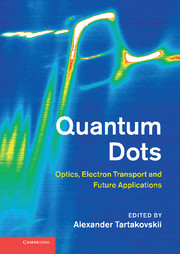Book contents
- Frontmatter
- Contents
- List of contributors
- Preface
- Part I Nanostructure design and structural properties of epitaxially grown quantum dots and nanowires
- Part II Manipulation of individual quantum states in quantum dots using optical techniques
- 4 Studies of the hole spin in self-assembled quantum dots using optical techniques
- 5 Resonance fluorescence from a single quantum dot
- 6 Coherent control of quantum dot excitons using ultra-fast optical techniques: the role of acoustic phonons
- 7 Holes in quantum dot molecules: structure, symmetry, and spin
- Part III Optical properties of quantum dots in photonic cavities and plasmon-coupled dots
- Part IV Quantum dot nano-laboratory: magnetic ions and nuclear spins in a dot
- Part V Electron transport in quantum dots fabricated by lithographic techniques from III–V semiconductors and graphene
- Part VI Single dots for future telecommunications applications
- Index
- References
4 - Studies of the hole spin in self-assembled quantum dots using optical techniques
from Part II - Manipulation of individual quantum states in quantum dots using optical techniques
Published online by Cambridge University Press: 05 August 2012
- Frontmatter
- Contents
- List of contributors
- Preface
- Part I Nanostructure design and structural properties of epitaxially grown quantum dots and nanowires
- Part II Manipulation of individual quantum states in quantum dots using optical techniques
- 4 Studies of the hole spin in self-assembled quantum dots using optical techniques
- 5 Resonance fluorescence from a single quantum dot
- 6 Coherent control of quantum dot excitons using ultra-fast optical techniques: the role of acoustic phonons
- 7 Holes in quantum dot molecules: structure, symmetry, and spin
- Part III Optical properties of quantum dots in photonic cavities and plasmon-coupled dots
- Part IV Quantum dot nano-laboratory: magnetic ions and nuclear spins in a dot
- Part V Electron transport in quantum dots fabricated by lithographic techniques from III–V semiconductors and graphene
- Part VI Single dots for future telecommunications applications
- Index
- References
Summary
Self-assembled quantum dots as host for spin qubits
A coherent spin in the solid-state would be very attractive for a number of applications. A single spin has an obvious application as a magnetic field sensor; entangled spin states can potentially enhance the sensitivity [54]. An optically active spin is a potential component of a quantum repeater, a technology to extend fibre-based quantum cryptography to large distances [41]. Also, a spin qubit is a potential building block of a quantum information processor [62]. But, applications aside, the targeted investigation of spin coherence in the solid-state is leading to new insights into the microscopic nature of the complex spin environment, allowing some old problems, for instance the central spin problem, to be fruitfully revisited.
The search for spin coherence in the solid-state has led most spectacularly so far to the NV− centre in diamond whose spin coherence can reach ˜1 ms even at room temperature [5]. However, diamond is difficult to process into a real device. Electron and hole spins in III–V semiconductors have yet to achieve the coherence of the NV− in diamond, but these materials have some considerable advantages. First, quantum dots can be used to confine electron spins to nanometer length scales [47, 61]. The quantum dots can either be defined electrostatically by local depletion of a two-dimensional electron gas, or they can be self-assembled during growth, for instance InAs on GaAs. Second, both a mature heterostructure technology and post-growth nanofabrication can be used to add functionality to the quantum dots.
- Type
- Chapter
- Information
- Quantum DotsOptics, Electron Transport and Future Applications, pp. 63 - 85Publisher: Cambridge University PressPrint publication year: 2012
References
- 2
- Cited by



